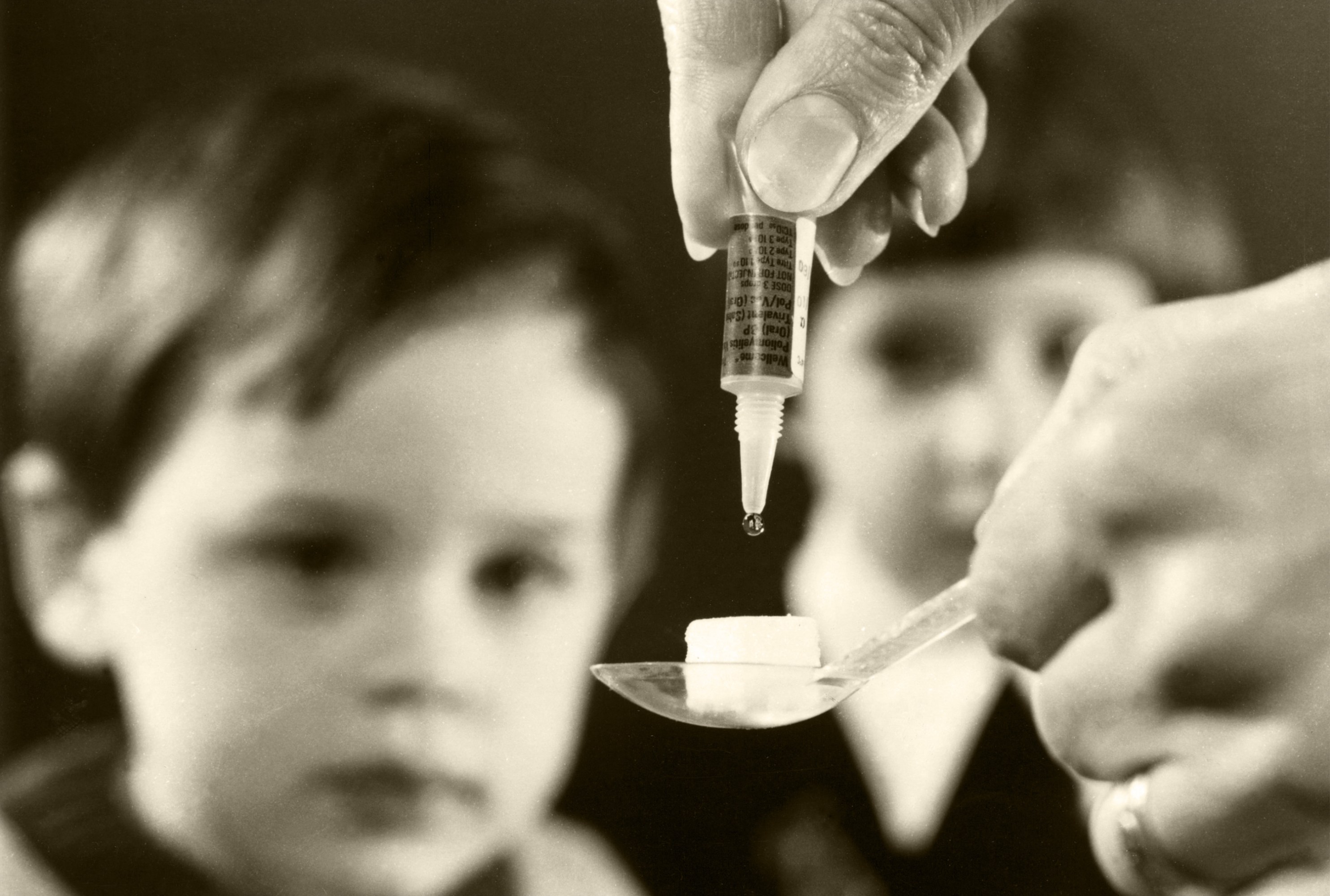
WELLCOME COLLECTION
In the 1950s, Albert Sabin was searching for an improved polio vaccine. To that end, his lab infected the brains of mice, chimpanzees, and monkeys with the virus that causes the disease. They wanted to see if the pathogen would change and if weakened forms might arise.
They eventually isolated versions of the polio virus that could still infect people but didn’t cause paralysis. Sabin’s so-called attenuated strains became the famous oral polio vaccine given on a sugar cube to billions of children.
Now, researchers say, synthetic biology has led to a way to create a weakened form of the pandemic coronavirus that causes covid-19. Although the idea remains a long-shot in the vaccine race, an attenuated coronavirus could be formulated into inexpensive nose drops for use around the world.
The startup company behind the new version of SARS-CoV-2, called Codagenix, is working with Serum Institute of India, based in Pune, which bills itself as the world’s largest vaccine maker. Plans are for the first volunteers to sniff up the synthetically designed virus starting in November, in initial human safety tests in the UK.
The most advanced covid vaccine candidates, including those from AstraZeneca and Moderna Pharmaceuticals, expose a person to only one part of the virus, the crown-shaped “spike” that gives it its name, in order to generate antibodies.
The potential advantage of a vaccine using an attenuated live strain is that the body will encounter–and be able to react to–the entire virus. People will “catch” it through their nose, and it will even grow inside them. In theory, that could prompt the formation of not just antibodies but also T cells and specialized forms of immunity in the nasal passage, leading to broader protection.
It might seem scary to imagine getting infected by the coronavirus on purpose, but attenuated-virus vaccines are common. The kids’ flu vaccine FluMist has a weakened influenza virus in it. And Serum Institute sells 750,000 doses a year of vaccines using live measles. The only disease ever successfully eradicated from the globe, smallpox, was wiped out with shots of a live virus.
“If you want to complete the immunological response, then you need to mimic the course of the disease,” says Rajeev Dhere, a director at Serum Institute. “This can only be done with live attenuated vaccine.”
Re-creating the virus
In the past, finding an attenuated strain to use as a vaccine was a painstaking process, says Stanley Plotkin, who advises Codagenix and was involved in early polio studies. That’s because it’s been done by growing a virus in cells from other species and waiting for a weaker strain to appear by chance. That can take 10 years. Sometimes a suitably behaving strain is never found.
A new, rational approach emerged in 2002. That is when Eckard Wimmer, a virologist at Stony Brook University, caused a sensation by creating infectious polio virus starting from only genetic instructions. It was the “first creation of life in a test tube,” according to the newspaper headlines, and a possible bioterror threat, too.
Some called Wimmer’s demonstration irresponsible. But the technology for generating viruses from data also allows researchers to get creative, since the procedure lets them rewrite the viral genes in any way they want. “That is where synthetic biology, genome editing, comes in. You can take evolution, which took years to occur, down to days,” says Farren Isaacs, a biologist at Yale University. “Unfortunately, the pandemic is creating an opportunity for this technology.”
Instead of creating dangerous germs, by 2008 Wimmer and J. Robert Coleman, then a member of his lab and now the CEO of Codagenix, had started showing how they could use synthetic biology to design weakened versions of polio using a strategy they called “synthetic attenuated-virus engineering” or, more colorfully, “death by a thousand cuts.”
To understand how they do it, it’s necessary to know that genes work using a three-letter code. To make proteins, a cell looks to these three-letter “codons” to determine which amino acid to add next to a protein it is building. But it turns out the genetic code has redundancy. There are 64 codons that can be spelled with the genetic alphabet, but only 20 amino acids to make. For instance, four codons code for the same amino acid, serine.
The way evolution has handled that redundancy matters, too. All life uses the same rules, but depending on whether you are a bacterium, a human, or a starfish, you will have a preference for using certain codons or pairs of codons.
Viruses, which hijack cells to copy their proteins, have, predictably, evolved a taste for the same codons that human cells prefer. But evolution’s choices can be reversed in the laboratory, in a process Codagenix calls “deoptimization.” Coleman says the company has made versions of the coronavirus whose genes are peppered with 240 mutations that endow it with some of the worst-performing codons.
The result: the engineered virus looks exactly the same on the outside but has a “virtual brake pedal” inside, causing it to replicate much less quickly. The coronavirus can usually make 100 million copies of itself inside a cell in about a day, but Coleman says the deoptimized version will copy itself half as well in the lab. Inside a person, it could be less efficient by a factor of up to 1,000, giving the immune system time to respond.
Some scientists don’t see a role for a live vaccine in the covid-19 fight. “This is a stupid easy virus to vaccinate against,” says Michael Farzan, a specialist at the Scripps Research Institute. He says the virus exposes its most important vulnerability, the spike protein, in a way that makes it a ready target for antibodies, which other vaccines can generate. “You only need live attenuated viruses when you don’t have a safer one. In this case it brings a risk that is unnecessary. There’s no need to have a live virus multiplying inside you.”
Serum Institute, which sells vaccines mostly in the developing world, is working to manufacture four potential coronavirus vaccines, including front-runners from Oxford University and Novavax, a US biotech company. These are in advanced stages of testing, but there is no guarantee they will work, and there could be supply shortfalls.
Dhere calls the live vaccine something of a backup plan for the Serum Institute. Such vaccines are made using old, well-established technology, and can be delivered without a needle. “The oral polio vaccine is so successful around the world because it’s a few drops in the mouth of a child. You don’t need a big medical paraphernalia,” he says. “So we felt that during a pandemic, the simplest version of a vaccine is the one that could reach billions of doses. When it goes to a mass scale, we think intranasal will be the best approach.”
Reversion risk
What are the risks? An attenuated virus can still be dangerous for people with compromised immune systems. Another risk is that a weakened virus can “revert” to its more dangerous form. “We always get the question if it will revert,” says Coleman.
That does occur with polio. In recent decades, more outbreaks have been caused by vaccine strains than by wild virus. According to Plotkin, that’s because only “relatively few” mutations distinguished Sabin’s vaccine strains from wild polio, and the attenuated virus (which does multiply inside people and even spreads between them) can eventually mutate back to its original form.
By contrast, the “deoptimized” coronavirus has several hundred genetic changes. The chances of evolution finding a way to undo even a fraction of them are mathematically minuscule. “I think it’s impossible,” says Dhere.
Rather than the vaccine strain reverting to the dangerous form, Dhere says bigger risk is that the wild coronavirus will mutate in ways that render certain vaccines less effective. The coronavirus hasn’t been changing very substantially so far: in fact, it’s been remarkably stable. Yet if the spike protein were to change, the main candidate vaccines could become less effective because they only target that molecule.
An attenuated live vaccine–because it includes all the parts of the virus–might not have that problem. “We don’t want to be chasing the virus if it changes,” he says. But if it does, “we’ll still have a vaccine that’s still 99% similar.”


